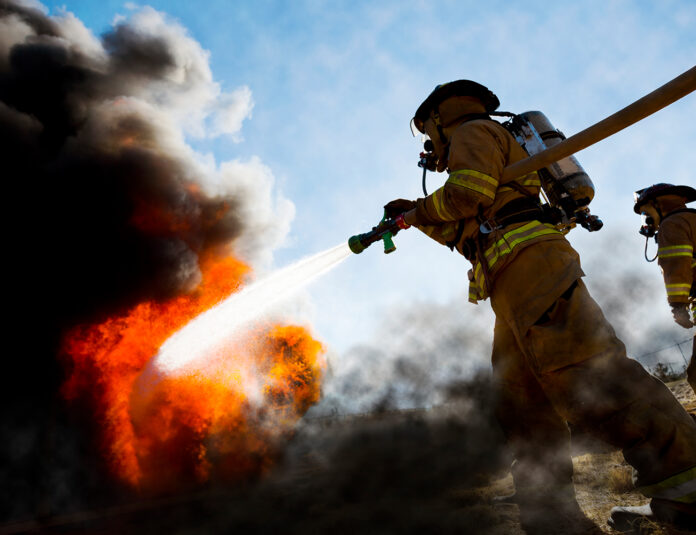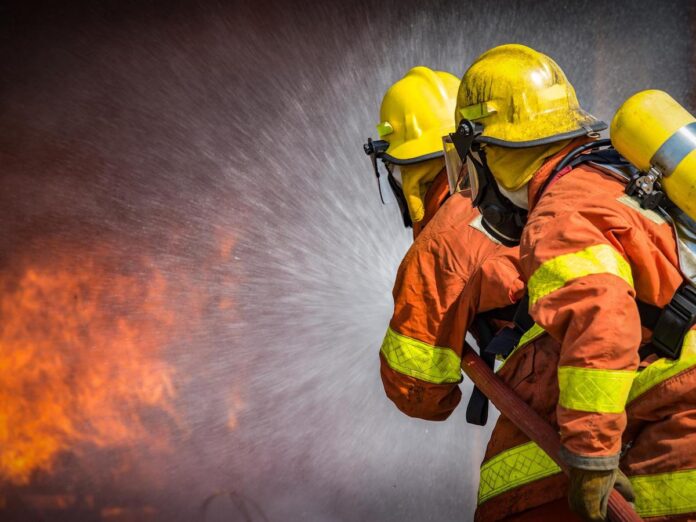
Firefighters, revered for their heroism, courageously battle blazes to protect lives and property.
Yet, behind the scenes, these brave men and women face a myriad of occupational hazards that jeopardize their health and well-being. From physical strains to exposure to toxic substances, the challenges are diverse and often underestimated.
In this article, we will dive into the multifaceted risks encountered by firefighters, shedding light on the complexities of their profession.
Physical Strain and Injuries
The physical demands placed on firefighters are immense. Carrying heavy equipment, navigating unpredictable terrains, and rescuing individuals in distress expose them to a high risk of musculoskeletal injuries.
NFPA notes that strains, sprains, and back injuries are common occupational hazards. These account for 36% of all injuries sustained by firefighters. Repetitive tasks, coupled with the need for swift response, contribute to the long-term physical toll on firefighters.
Departments emphasize fitness programs and proper lifting techniques, but the persistent threat of physical injuries remains a formidable challenge in the firefighting profession.
Respiratory Challenges in Hazardous Environments

In the heart of emergencies, firefighters confront environments filled with smoke, toxic fumes, and particulate matter. Prolonged exposure to these hazardous substances poses a significant risk to respiratory health.
According to CSFA, the inhalation of carbon monoxide, benzene, and other toxic chemicals can lead to chronic conditions such as asthma and COPD. Adequate respiratory protection, including the use of SCBA (Self-Contained Breathing Apparatus), is vital to safeguard firefighters from the detrimental effects of airborne contaminants.
Psychological Toll of Emergency Response
Beyond the physical challenges, firefighters face a profound psychological toll. The nature of their work exposes them to traumatic incidents, death, and human suffering.
Post-traumatic stress disorder (PTSD), anxiety, and depression can affect the mental well-being of firefighters. Research published by the NIH indicates that the occurrence rate of PTSD among firefighters in the United States ranges from 8% to 22%.
Peer support programs, mental health resources, and counseling services are increasingly recognized as crucial elements in addressing the emotional challenges associated with emergency response.
Chemical Exposures in Structural Fires
Structural fires release a complex mix of toxic chemicals, including carcinogens and harmful substances. Firefighters battling these blazes are at risk of direct skin contact and inhalation exposure.
Long-term health risks, such as an increased likelihood of cancer, underscore the importance of robust protective measures. Initiatives focusing on advanced personal protective equipment (PPE), decontamination protocols, and awareness campaigns are essential to mitigate the health hazards associated with chemical exposures.
Radiation Risks in Modern Urban Fires

Modern urban environments often feature materials that, when burned, can emit hazardous radiation.
Firefighters responding to incidents involving radioactive materials face potential exposure risks. Proper training, equipment, and adherence to safety protocols are critical to minimizing the risks associated with radiation exposure.
Vigilance in recognizing and responding to incidents involving radioactive materials ensures the safety of firefighters and the surrounding community.
Heat Stress and Dehydration
The intense heat generated in firefighting scenarios puts responders at risk of heat stress and dehydration. Wearing protective gear adds to the challenge, limiting the body’s ability to dissipate heat.
Proper hydration strategies, rotating personnel to prevent prolonged exposure, and implementing cooling measures on-site are essential to prevent heat-related illnesses.
Fire departments prioritize training on recognizing early signs of heat stress and ensuring personnel are equipped to handle extreme temperature conditions.
Aqueous Film-Forming Foam Controversy
The use of AFFF has become a subject of controversy due to risks associated with its chemical composition, particularly per- and polyfluoroalkyl substances (PFAS). Firefighters employing AFFF to suppress flammable liquid fires may face exposure risks.
According to TorHoerman Law, ongoing lawsuits against foam manufacturers question the responsibility of these entities in informing firefighters about the potential health risks.
Regulatory bodies, including the National Fire Protection Association (NFPA), are under scrutiny for potential oversight of testing standards. The AFFF controversy highlights the complex intersection of firefighting practices, chemical exposure, and the pursuit of firefighter safety.
3M recently proposed a tentative $10 billion settlement in an attempt to address litigation from multiple U.S. cities and towns. This sizable settlement suggests a recognition on the part of 3M regarding the serious health concerns associated with AFFF. Such sizable AFFF lawsuit settlement amounts underscore the acknowledgment of potential health risks associated with PFAS in firefighting foam.
While these settlements signify a recognition of responsibility on the part of manufacturers, the legal landscape surrounding AFFF is far from settled. The settlements underscore the significant impact of the controversy in terms of financial compensation and broader implications for the safety of firefighters involved.
Sleep Deprivation and Shift Work Challenges

Firefighters often work in demanding shift schedules, including extended hours and overnight shifts. The irregular work hours, combined with the unpredictable nature of emergencies, contribute to chronic sleep deprivation.
Prolonged periods without adequate rest not only impair cognitive function but also heighten the risk of accidents and injuries.
Addressing the challenges of sleep deprivation involves implementing fatigue management strategies, promoting restorative breaks, and fostering a culture that prioritizes the well-being of firefighters.
Infectious Disease Risks and Emergency Medical Response
Beyond the hazards of fire, firefighters are frequently involved in emergency medical response, exposing them to infectious diseases.
Responding to accidents, medical emergencies, and disasters may involve close contact with individuals carrying contagious pathogens. Proper training, adherence to infection control protocols, and access to personal protective equipment are crucial in mitigating the risks of infectious disease transmission.
The ongoing global health landscape further underscores the importance of vigilance and preparedness for emerging infectious threats in the context of emergency response.
In conclusion, the brave individuals who battle blazes as firefighters encounter a myriad of intricate occupational hazards. From physical strains and chemical exposures to psychological tolls, the diverse risks emphasize the imperative for comprehensive safety measures.
Controversies surrounding AFFF and substantial settlements underscore the evolving landscape of firefighter safety. As we honor their heroism, advocating for ongoing research and holistic approaches becomes crucial.
Recognizing the intricate challenges these courageous men and women face, it is critical to ensure their well-being through continued commitment to robust protective measures.





